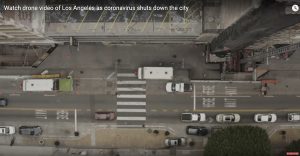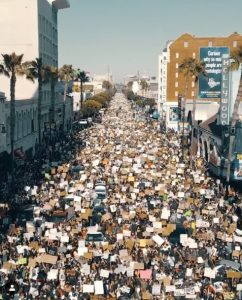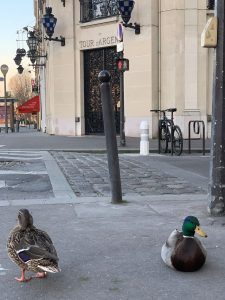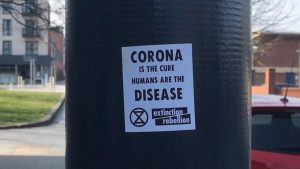Of Drones and the Environmental Crisis in the Year of 2020
As coronavirus lockdowns left the world’s cities deserted, drone footage of empty towns made its appearance on video-sharing platforms. Across the globe, observers insisted on the melancholic feelings that such “post-apocalyptic” images aroused. This essay proposes to read these images against the background of our current ecological crisis, highlighting their connections to drone footage of anti-racist protests and to footage of wild animals taking over lockdown cities around the world. Attention will be drawn to their problematic aestheticization of politics, in particular when it comes to ecological thinking.
As I write this text, in June 2020, George Floyd’s body has just been put to rest. Across the globe, people have taken to the streets, protesting against racial discrimination and toppling statues of slave traders and colonialist rulers. In mid-March, when the world was progressively brought to a standstill by a bewildering pandemic, it was hard to imagine that the year 2020 would be remembered for anything else than Covid-19, a cunning virus strain that spilled over from bats to humans and is still taking lives. But our current and elusive enemy has brutally exposed a world fraught with economic and racial inequalities.
What do anti-racist protests have to do with coronavirus drone footage? I bring them up for two reasons. First, because this text is an immediate reaction to the political questions raised by such footage, and as such, a response deeply embedded in the present moment. We’ve had little time to reflect on the massive amount of images inspired by the outbreak. If the history of aerial imagery can help us to better grasp some of the issues at stake, some of these problems strike me as intimately related to the nature of our times. In this sense, the powerful George Floyd protests that we are witnessing are part of the equation: they’re all the more relevant as enormous crowds filled the streets, shortly after virus lockdowns across all continents left them deserted. Against the rising specter of surveillance societies, drone flyovers of such massive demonstrations—and this is my second point—have become inseparable from aerial views of cities transformed into ghost towns. The uncanniness of Los Angeles’s eerily quiet streets, shot on March 20th, appears even more staggering when compared to the extraordinary images of Hollywood Boulevard swarming with protesters on June 8th.[1] My discussion of coronavirus drone footage will keep these images in mind—as it will summon very different pictures made during the pandemic, such as footage of wild animals taking over lockdown cities around the world. By juxtaposing these apparently disparate elements, I wish to highlight their underground connection. On the one hand, they all evoke the policing and monitoring of human and non-human bodies, as well as the belief that some lives are more valuable than others. On the other hand, they refer to a problematic “aestheticization of politics,” in particular when it comes to ecological thinking.


Fig. 1. Los Angeles on March 20th and Los Angeles on June 8th, 2020.
Coronavirus Drone Footage
“Uncanniness” is a good starting point. As drone footage of unusually desolate cities popped up on video-sharing platforms, the words “awe-inspiring” and “post-apocalyptic” came up almost immediately. In early February, an evocative assemblage of drone sequences captured in the city of Wuhan, then under strict lockdown, was widely relayed.[2] Some qualified it as “haunting,” mentioning “scenes reminiscent of a post-apocalyptic movie” (O’Brian 2020); others evoked a “spectral situation” (Anonymous 2020). As the pandemic spread to more than 200 countries and aerial footage of other cities under lockdown was broadly circulated, observers insisted on the “eerie beauty” of such once familiar and now “ghostly towns,” as well as on the melancholic feelings they aroused.
As vehicles that have access to humanly impossible movements and points of view, drones are uncanny by nature. So are the images they produce: Harun Farocki’s expression, “subjective phantom images,” evokes such uncanniness well (Farocki 2004). Police surveillance drones generated much of this footage, destined first and foremost for humans and machines to monitor and therefore inseparable from disciplinary power structures.[3] Despite this (whether shot by the police, civilians or major news organizations, coronavirus drone footage is strongly embedded in the surveillance society), such pictures cannot be described as fully “operative,” that is, as images made by machines for machines, “neither to entertain nor to inform” (Farocki 2004, 17). While illustrating an iteration of logistical images, coronavirus drone footage doesn’t totally exclude the human eye. Its horizon might be full automation, but human intermediaries are still present. Moreover, as they enter the maelstrom of visual culture, such images escape their purely instrumental destiny and become aesthetic objects offered to the contemplation of their anxious, confined spectators. Drone footage of cities under lockdown evokes the longer history of urban cinematic views (Castro 2017). The feeling of flight, as well as the extraordinary mobility of their point of view, was (and is) as important as the enjoyment experienced in observing the city from an unusual point of view. The pleasure inherent to coronavirus drone footage equally lies in this oscillation between visual and kinaesthetic perception, referring to cultural practices of looking that go beyond the military expediency of drones.[4]
Like some of these earlier views, coronavirus drone footage has a strong affective dimension. Even sequences documenting deserted tourist hotspots, inviting their viewers to experience entertaining virtual tours from the safety of their homes, seem shrouded in an elegiac veil, often reinforced by atmospheric soundtracks.[5] A clip entitled The Silence of Rome is absolutely exemplary.[6] While the video’s aesthetics perfectly illustrates the corporate, promotional look in which its maker specializes, the ambient soundtrack encourages contemplation.[7] In one of the first pieces on coronavirus drone footage, Patricia Zimmerman and Caren Kaplan have pointed out the melancholic, almost mournful nostalgia, of such aerial images (Kaplan and Zimmermann 2020). Despite their innocuous appearance, such reactions are deeply political. As Zimmerman observes, “the affective response (…) seems like a form of romanticism available only to the privileged with time to meditate on emptiness and revel in it” (Kaplan and Zimmerman 2020). Indeed, coronavirus drone footage illustrates in many ways a worrying aestheticization of politics, and not only because it primarily speaks to the world’s privileged.
Drones and the Aestheticization of Ecological Politics
The expression “aestheticization of politics” was first used by Walter Benjamin in order to address fascism’s “glorification of war” (Benjamin 2008, 41). Siegfried Kracauer’s discussion of the mass ornament (and aerial views), illustrates well what the aestheticization of political life meant during those gloomy interwar years (Kracauer 1995; Castro 2013). I will use this idea in a different way. It seems to me that the pleasurable and affective dimensions of coronavirus drone footage—their inherently aesthetic features—induce, in the public sphere, a worrying victory of spectacle over criticism. This is particularly evident when it comes to ecological thought—an aspect otherwise disregarded by discussions on the automation of vision. As a human-made crisis (not because the virus was fabricated in a lab, but because its spill-over was driven by human activities), the current pandemic links explicitly to ecology and to our troubled relationship with the “natural” world. As governments imposed more or less strict social distancing regulations, commentators were quick to suggest that this was the first major crisis of the Anthropocene (Tooze 2020). Discussions on the positive and negative environmental outcomes of the outbreak thrived: the most optimistic anticipated a new era of ecological consciousness. As satellite images revealed significant drops in air pollution across the planet, drone footage of emptied cities came to embody, for some, what the world would look like without humans—or, at least, with considerably fewer humans. Images (many of them fake) of wild animals returning to human-deserted metropolises were widely shared.[8] In the UK and some parts of Europe, false Extinction Rebellion (XR) stickers proclaimed: “Corona is the cure, humans are the disease.” XR quickly dismissed them: they were the creation of far-right activists, who not only wished to discredit the group, but to promote “eco-fascism” (Manavis 2020).

Fig. 2. Two ducks in front of the restaurant Tour d’Argent, Paris. Photograph posted on Twitter by @sisyphe007 on March 31, 2020.

Fig. 3. False Extinction Rebellion sticker: “Corona is the cure, humans are the disease.”
In what feels like a long time ago, in the far-away galaxy of our pre-pandemic world, self-proclaimed eco-fascists murdered a significant number of people in El Paso and Christchurch (Darby 2019). Eco-fascism certainly precedes the outbreak (Gardiner 2020). But as drone footage of emptied cities suggested that the world had turned into a nuclear-disaster exclusion zone where “nature” was regaining its rights, eco-fascists seized the occasion. Their credo: to preserve the planet over certain lives, in particular black, indigenous and other minority ethnic lives. The very idea that “humans are the virus”—a meme tweeted and relayed countless times during lockdown, and somewhat inseparable from drone footage and satellite images—is inherently problematic. While human activities are certainly behind the environmental crisis, the genocidal view according to which COVID-19 is the planet’s answer to the “human virus” is untenable. In practical terms, those being “sacrificed” are the frailest in terms of health, age, and economic position: the poor, the homeless, the incarcerated, the displaced, the marginalized, etc. If drone footage of emptied cities and “cute” images of wild animals exploring the world’s metropolises serve the “humans are the virus” credo, environmental politics is neutralized (if not aestheticized): the real reasons behind our current crisis are not addressed, they become a spectacle.
The link between racial justice and the environmental crisis must be acknowledged. Racial (and gender) inequality and environmental destruction go hand in hand (Ferdinand 2019). In this context, the human and non-human bodies absent or present in drone footage of lockdown (and post-lockdown) cities are significant. While the real impact of the crisis on environmental consciousness still needs to be seen, the pandemic feels like an occasion to land on Earth (Latour 2018 and 2020).[9] According to French sociologist Bruno Latour, the modern project has been “in flight,” detached from the soil, plants, animals, life. But we cannot escape the ecological urgency anymore: the reality of anthropogenic climate change is making the planet uninhabitable and now begs for a terrestrial politics. Latour’s argument appears as particularly relevant for a discussion on aerial imagery: if the disjunction between the world we live in and the world we live from is at the heart of our current environmental crisis, points of view matter. In other words, from where do we see the world? In this context, the mapping and surveying of the planet from an aerial perspective undoubtedly contributed to our remoteness from it. Beyond the general feeling of mastery and control over space that maps procure, cartography has played (and still plays) a decisive role in the process of extracting natural resources from the Earth. Maps have helped to transform “nature” into an entity to be mastered and exploited. Transitioning from what we could call a cartographic to an ecological reason means, among other things, adjusting our standpoints to more small-scale and non-objectifying points of view, imagining counter-mappings. In order to truly inhabit the planet and to make it a world worth living in, we need to tackle its problems. As far as environmental politics is concerned, so long drone hovering and detached views: we need to put our feet back on Earth.
References
Anonymous. 2020. “Coronavirus Cina, le immagini dal drone di Wuhan diserta,” Sky tg24, 6 February 2020. Accessed June 11, 2020. https://tg24.sky.it/mondo/2020/02/06/coronavirus-wuhan-video-drone.
Benjamin, Walter. “The Work of Art in the Age of Its Technological Reproducibility: Second Version.” In The Work of Art in the Age of Its Technological Reproducibility and Other Writings on Media, ed. Michael W. Jennings, Rodney Livingstone and Thomas Y. Levin, 19-55. Cambridge, Massachusetts, London, England: The Belknap Press.
Castro, Teresa. 2013. “L’Ornement de la masse, de Weimar à Hollywood”. In Vues d’en haut, ed. Angela Lampe, 253-259. Metz: Centre Pompidou Metz.
Castro, Teresa. 2017. “Cinematic cartographies of urban space and the descriptive spectacle of aerial views (1898-1948).” In Cinematic Urban Geographies, edited by Richard Koeck and François Penz, 47-63. London: Palgrave/ Macmillan.
Darby, Luke. 2019. “What is Eco-fascism, the Ideology Behind Attacks in El Paso and Christchurch,” GQ, August 7. Accessed June 11, 2020. https://www.gq.com/story/what-is-eco-fascism
Farocki, Harun. 2004. “Phantom Images.” Public 29: New Localities: 12-22.
Ferdinand, Malcom. 2019. Une écologie décoloniale: Penser l’écologie depuis le monde caribéen. Paris: Seuil.
Gardiner, Beth. 2020. “White Supremacy Goes Green. Why is the far right suddenly paying attention to climate change?”, The New York Times, Feb 28, Accessed June 11, 2020. https://www.nytimes.com/2020/02/28/opinion/sunday/far-right-climate-change.html
Kaplan, Caren and Patricia R. Zimmermann. 2020. “Coronavirus Drone Genres: Spectacles of Distance and Melancholia,” Film Quarterly, posted on April 30th 2020. Accessed June 11, 2020. https://filmquarterly.org/2020/04/30/coronavirus-drone-genres-spectacles-of-distance-and-melancholia/
Kracauer, Siegfried. 1995. “The Mass Ornament.” In The Mass Ornament. Weimar Essays, ed. Thomas Y. Levin, 75-88. Cambridge, Massachusetts, London, England: Harvard University Press.
Latour, Bruno. 2018. Down to Earth. Politics in the New Climactic Regime. Cambridge: Polity Press.
Latour, Bruno. 2020. “Seven Objections Against Landing on Earth.” In Critical Zones. The Science and Politics of Landing on Earth, ed. Bruno Latour and Peter Weibel, 9-24. Karlsruhe: ZKM Center for Art and Media.
Manavis, Sarah. 2020. “Is coronavirus leading to a rise in eco-fascism,” New Statesman, May 11. Accessed 11 June, 2020. https://www.newstatesman.com/science-tech/social-media/2020/05/coronavirus-leading-rise-eco-fascism
Tooze, Adam. 2020. “We are living through the first economic crisis of the Anthropocene,” The Guardian, May 7. Accessed June 11, 2020. https://www.theguardian.com/books/2020/may/07/we-are-living-through-the-first-economic-crisis-of-the-anthropocene
Endnotes
[1] See https://www.youtube.com/watch?v=O51LOuQzROI, posted by The Washington Post on YouTube on March 20th, as well as Ron Kurokawa’s viral drone footage, documenting a march organized by Black Lives Matter BLD, PWR and local LA rapper YG : https://www.instagram.com/p/CBKLOkAhGEV/, posted on Instagram on June 8th. All accessed June 11, 2020.
[2] “Drone Footage shows Wuhan under lockdown,” The New York Times, February 4, 2020. Accessed June 11, 2020. https://www.nytimes.com/video/world/asia/100000006960506/wuhan-coronavirus-drone.html. The footage was shot by a Chinese photojournalist and edited by The New York Times.
[3] See, for instance, https://www.youtube.com/watch?v=bpe-ARGSi-w (drone and time-lapse footage of Paris before and under lockdown, put together by the French police and posted online on March 28th 2020, accessed June 11 2020) and https://www.youtube.com/watch?v=ND1EIf7s2d4 (drone footage from the Barcelona lockdown shot by the Catalonian “Mossos de esquadra,” posted online of April 20, 2020, accessed June 11, 2020). I will not address other features of these so-called “pandemic drones” in this essay, which, beyond monitoring social distance and quarantined individuals, claim to remotely pick up the heart rate and temperature of people, or to know if they’re wearing a mask. Note also that talking drones equipped with speakers were used in different countries during lockdown, from China to Portugal.
[4] In addition to this, it should be pointed out that despite its military origins, drone technology is sometimes used in order to undermine the same power regime that produced them. See, for instance, the way in which the No Dakota Access Pipeline movement used drones in order to monitor police activities. See https://www.youtube.com/watch?v=uXWw0y44xaM (posted on YouTube December 2, 2016).
[5] See, among countless examples, drone footage of quarantined San Francisco, https://www.youtube.com/watch?v=yQky8qARcwc (posted on YouTube April 2, 2020), Chicago https://www.youtube.com/watch?v=-8Ia03Ve1fc (posted on You Tube April 11th 2020), Florence https://www.youtube.com/watch?v=zTJvE7BIZTo (posted on YouTube March 28, 2020) or Lisbon https://www.youtube.com/watch?v=VSsarnHMXbA (posted on You Tube April 3, 2020). All accessed June 11, 2020. The platform Airvūz, “the premiere online video sharing community for the emerging Drone Age,” compiles a large number of drone lockdown footage shot all-over the world (see https://www.airvuz.com/). Drone DJ, a website specialized in the drone industry, also made compilations of coronavirus drone footage. See https://dronedj.com/2020/04/01/ultimate-coronavirus-drone-footage-roundup-usa-china-italy-spain-and-more/ (posted on April 1st 2020, accessed June 11, 2020).
[6] The video was shot by shot by a certain Luigi Palumbo, a professional drone operator. See Il Silenzio di Roma, posted by Invidiosrl, April 7, 2020. Accessed June 11, 2020. https://www.youtube.com/watch?v=kFGZKUxJwkM.
[7] Some of the viewers’ responses, left on the comments section, are worth quoting: “beautiful and sad” or “wonderful and truly moving video clip, poetically beautiful Rome, wounded in the heart by the sirens in their sad silence, in order to rescue lives from the virus” (“Stupendo video clip davvero commovente, Roma poeticamente meravigliosa, ferita al cuore dalle sirene nel suo triste silenzio, per strappare vite al virus”). On the author’s Instagram account, an aerial photograph of Victor Emmanuel II Monument is accompanied by the comment mala tempora currunt (“bad times are upon us”). See https://www.instagram.com/p/CBIMIZQh8TU/, posted June 8, 2020. Accessed June 11, 2020.
[8] See, among others, “Coronavirus Outbreak: Animals Take to Streets among Lockdown,” posted by India Today on YouTube, April 10, 2020. Accessed June 11, 2020. https://www.youtube.com/watch?v=_DSLP95CR2k; and “6 Things that prove that the Earth is Healing,” posted on YouTube by Curly Tales, March 23, 2020. Accessed June 11, 2020. https://www.youtube.com/watch?v=R3M908TJG9M.
[9] In addition to Bruno Latour’s idea that politics should be redefined as what leads towards the Earth (and not the global or the national—the “ethnonational” according to eco-fascism), “landing” should potentially be a way to think about the necessary articulation between a “cartographic” and an “ecological” reason. For more or less obvious reasons, aerial views play an important role in this conundrum.